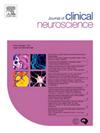Anatomy of the sellar barrier: From magnetic resonance imaging to the operating room
IF 1.9
4区 医学
Q3 CLINICAL NEUROLOGY
引用次数: 0
Abstract
Background
The sellar barrier concept concerns the correlation between the components of the pituitary fossa roof and the risk of intraoperative cerebrospinal fluid (CSF) leak during pituitary tumor surgery. Our team previously classified the sellar barrier according to its thickness on contrast-enhanced T1-weighted magnetic resonance imaging (MRI) sections into three subtypes: strong, mixed or weak.
The purpose of this study is to complement the preoperative analysis of the sellar barrier with T2-weighted MRI sections to enhance our knowledge of the anatomical configuration of the sellar barrier and its correlation with the intraoperative findings.
Method
A retrospective descriptive study was performed in which medical records, neuroimaging and surgical videos of patients undergoing endoscopic endonasal surgery for pituitary tumors from January 2021 to January 2024 were reviewed. In all cases, the anatomy of the sellar barrier was evaluated by an expert neuroradiologist using pre-surgical T1-weighted MRI with gadolinium and T2-weighted images with sagittal and coronal cuts. Subsequently, the anatomical structures of the sellar barrier were compared with the direct endoscopic view observed in the operating room.
Results
A total of 108 patients were included in this study. According to the preoperative neuroimaging findings, an experienced neuroradiologist classified the type of sellar barrier as strong, mixed or weak. Additionally, the T2-weighted imaging study was systematically implemented to identify the anatomical components of the sellar barrier. We found a high correlation between the preoperative neuroimaging description and the intraoperative endoscopic view of the sellar barrier. We present eight illustrative cases herein.
Conclusions
The use of T2-weighted sequences in conjunction with gadolinium-enhanced T1-weighted images enhances the preoperative knowledge of the sellar barrier by discriminating its anatomical components with high precision. As in any neurosurgical procedure, a detailed preoperative neuroimaging study and evaluation is highly recommended in order to offer the best possible treatment to our patients affected by pituitary tumors.
鞍区屏障的解剖:从磁共振成像到手术室
鞍屏障的概念涉及垂体瘤手术中垂体窝顶成分与术中脑脊液泄漏风险之间的关系。我们的团队先前根据对比增强t1加权磁共振成像(MRI)切片的厚度将鞍区屏障分为三种亚型:强、混合或弱。本研究的目的是补充术前用t2加权MRI切片对鞍区屏障的分析,以增强我们对鞍区屏障解剖结构及其与术中发现的相关性的认识。方法回顾性分析2021年1月至2024年1月行鼻内窥镜垂体肿瘤手术患者的病历、神经影像学和手术录像。在所有病例中,神经放射学专家使用术前t1加权MRI带钆和t2加权图像矢状面和冠状面切口对鞍区屏障的解剖进行评估。随后,将鞍区屏障的解剖结构与在手术室直接内镜下观察的解剖结构进行比较。结果本研究共纳入108例患者。根据术前神经影像学结果,经验丰富的神经放射学家将鞍区屏障的类型分为强、混合型和弱型。此外,系统地实施了t2加权成像研究,以确定鞍区屏障的解剖组成。我们发现术前神经影像学描述与术中鞍区内窥镜影像高度相关。我们在此提出八个说明性案例。结论t2加权序列与钆增强t1加权图像结合使用,可以高精度地识别鞍区解剖成分,增强术前对鞍区屏障的认识。在任何神经外科手术中,为了给垂体瘤患者提供最好的治疗,强烈建议术前进行详细的神经影像学研究和评估。
本文章由计算机程序翻译,如有差异,请以英文原文为准。
求助全文
约1分钟内获得全文
求助全文
来源期刊

Journal of Clinical Neuroscience
医学-临床神经学
CiteScore
4.50
自引率
0.00%
发文量
402
审稿时长
40 days
期刊介绍:
This International journal, Journal of Clinical Neuroscience, publishes articles on clinical neurosurgery and neurology and the related neurosciences such as neuro-pathology, neuro-radiology, neuro-ophthalmology and neuro-physiology.
The journal has a broad International perspective, and emphasises the advances occurring in Asia, the Pacific Rim region, Europe and North America. The Journal acts as a focus for publication of major clinical and laboratory research, as well as publishing solicited manuscripts on specific subjects from experts, case reports and other information of interest to clinicians working in the clinical neurosciences.
 求助内容:
求助内容: 应助结果提醒方式:
应助结果提醒方式:


